| |
|
| |
General Remarks |
 |
The Cyprus Museum can be found in the Greek part of Nikosia (or Lefkosia, as the
Turks call it). While its goodies are not in the same league as those in the museums in Athens, Rome or Istanbul, a visit
is definitely worthwhile. As far as metal objects are concerned, it has quite a few, far more than the 8 museums in Rome
combined that I visited in 2016. |
|
 |
However, if you hope to learn something about the Copper and Bronze industry
that was so prominent in Cyprus from about 2500 BC to 500 AD, or about the role
of Cyprus in pioneering iron, you will be disappointed.
That is not to say that there aren't any artifacts concerning copper, bronze and iron, just that not much relates to the
topics mentioned. |
 |
A few general points first:
- The illumination is quite mixed. In some rooms it is rather good, in others it is abysmal.
- The explanations are short but generally adequate.
- There are even books about the museum with good pictures (a pleasant surprise!)
- Taking pictures (no flash, of course) is allowed but a bit difficult since there are lots of reflections.
The museum is full of ceramics. One does find the usual Greek pots and so on but also unique and quite charming things
(see below). Quite interesting are replicas of graves with the goodies still in there (including the owner), and cases that
show ceramics from various times grouped around a common topic.
I will first present a bunch of pictures (plus some
text) on non-metallic objects and then turn to the metal stuff. I will include some pictures from other museum on Cyprus
when adequate. |
| | |
|
| |
Some Non-Metallic Objects of General Interest (to Me) |
 |
The most spectacular exhibit is a group of 2000 terra-cotta figurines from the
6th and 7th century BC, found in the sanctuary of Ayia Irini. Sizes range from life-size to miniature, and the grouping
reproduces the way the figurines were found. The pictures below can only give a weak impression of that breathtaking ensemble: |
| | |
|
| |
|
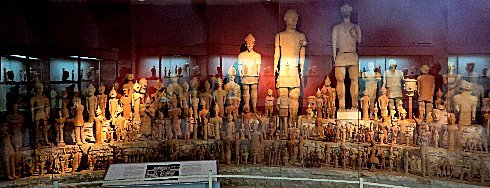 |
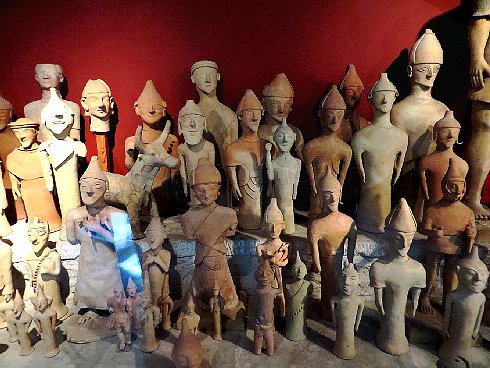 |
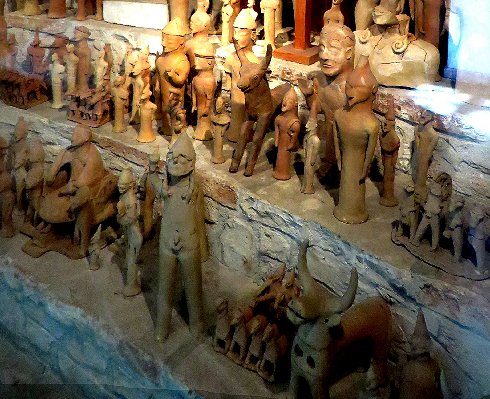 |
| Figurines deposited in the sanctuary of Ayia Irini. All but 2 are male, |
| Source: Photographed in the Cyprus Museum in Oct. 2016 |
|
| | |
|
|
 |
The sanctuary was in use from about 1200 BC to 600 BC or so. It does remind one
of places like Altötting in Bavaria, where (catholic) people deposit sculptures of bodies and body parts in the hope
of a better future concerning the health of same. |
 |
Lots of things are of a charming naivete, outright
playful or just funny (to us): |
|
| |
| |

Large version |
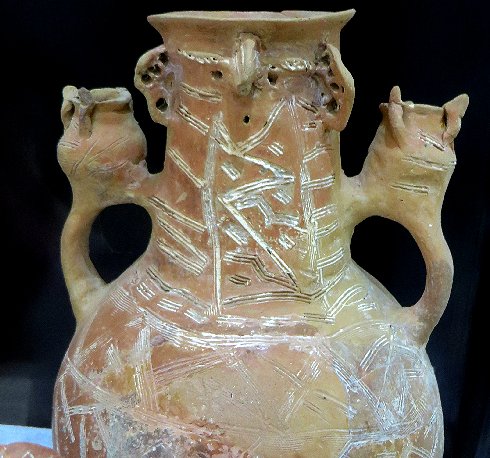 |
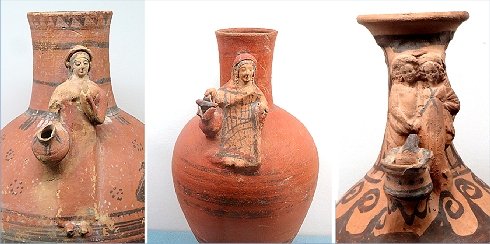
One more |
| Charming pots and ceramics. The top ones are from the "Bronze Age", the bottom
ones from around 500 BC |
| Source: Photographed in the Cyprus Museum in Oct. 2016 |
|
| | |
|
 |
Most everything was found in graves, and there are a few cool settings
of of typical sepulchres containing the real artifacts including the remains of the owner: |
| | |
|
|
|
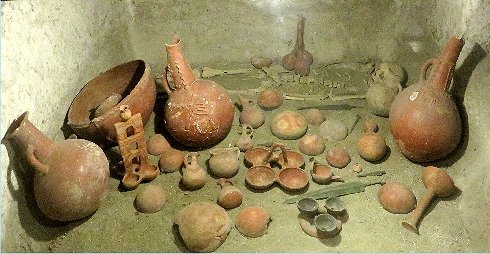 |
| What a grave looked like. Note the (obviously valuable) bronze weapons |
| Source: Photographed in the Cyprus Museum in Oct. 2016 |
|
| | |
|
 |
Here is an example of the topical exhibits mentioned above. The topics
shown are is "Ritual" and "Warriors, Riders". Other topics are "Music; Dance or "Cult, Myth". |
| | |
|
 |
Of course the museum has a lot of stone and marble sculptures plus a few bronze
ones. Some are rather good, the rest is often quite interesting if not of prime artistic value. Here are two highlights: |
| | |
|
| |
|
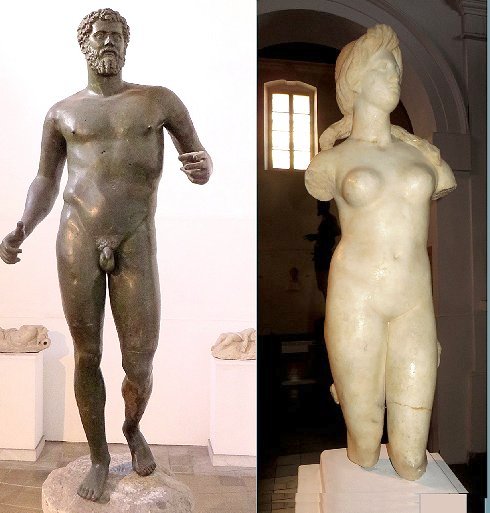 |
Roman Emperor Septimius Severus (193 - 211 AD)
Aphrodite (my guess)
|
| Source: Photographed in the Cyprus Museum in Oct. 2016 |
|
| | |
|
 |
Last, a few examples of the topical exhibits mentioned above. The
topics shown are "Warriors, Riders" and "Ritual". Other topics are "Music; Dance" or "Cult,
Myth". |
| |
|
|
|
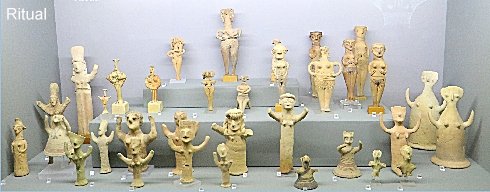 |
 |
| Warriors, Riders |
| Source: Photographed in the Cyprus Museum in Oct. 2016 |
|
| | |
|
| |
|
 |
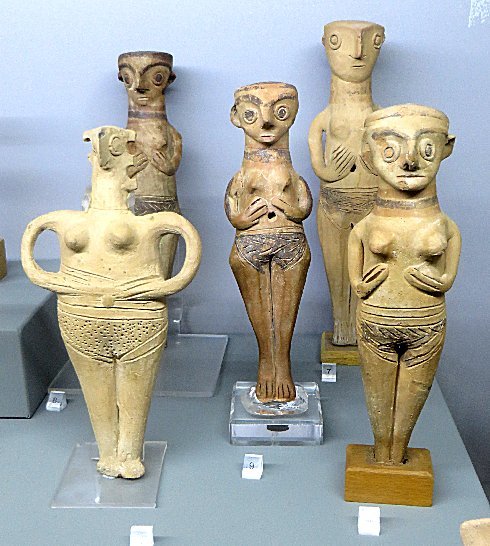 |
| Ritual |
| Source: Photographed in the Cyprus Museum in Oct. 2016 |
|
| | |
|
| |
Some Metallic Objects |
 |
There is a big room full of metal objects, the picture below gives an idea: |
| | |
|
|
|
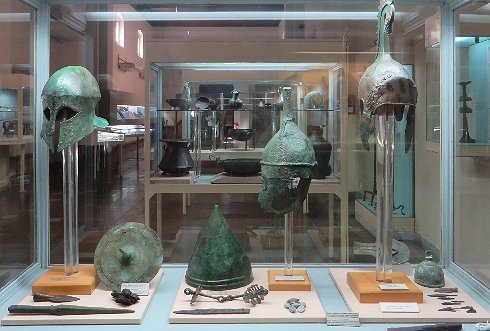 | | Succession of cases with metal objects |
| Source: Photographed in the Cyprus Museum in Oct. 2016 |
|
| | |
|
|
 |
We have very well preserved (Greek type) helmets and all kinds of vessels in
the background. The we have the major show pieces: |
|
| |
| |
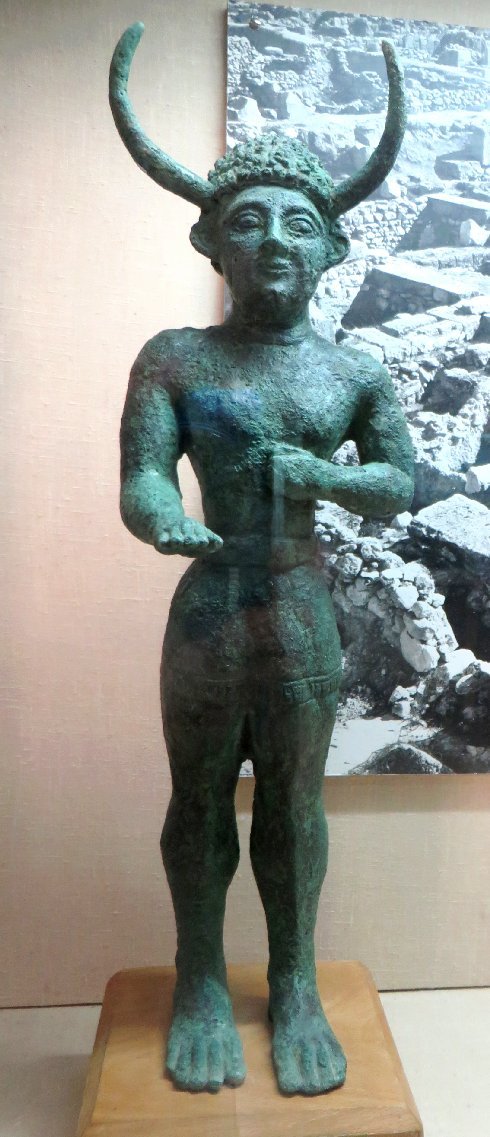 | | Famous "Horned God" |
| Source: Photographed in the Cyprus Museum in Oct. 2016 |
|
| | |
|
|
|
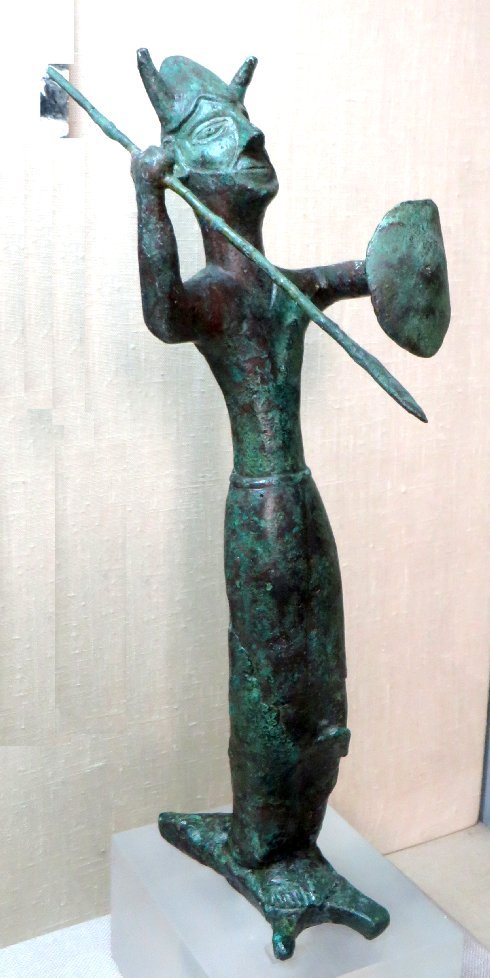 |
| The "Copper" God, standing on an oxhide Copper ingot. 12th century BC |
| Source: Photographed in the Cyprus Museum in Oct. 2016 |
|
| | |
|
 |
The museum does have (badly cast) oxhide ingots, sort of: |
| | |
|
| |
|
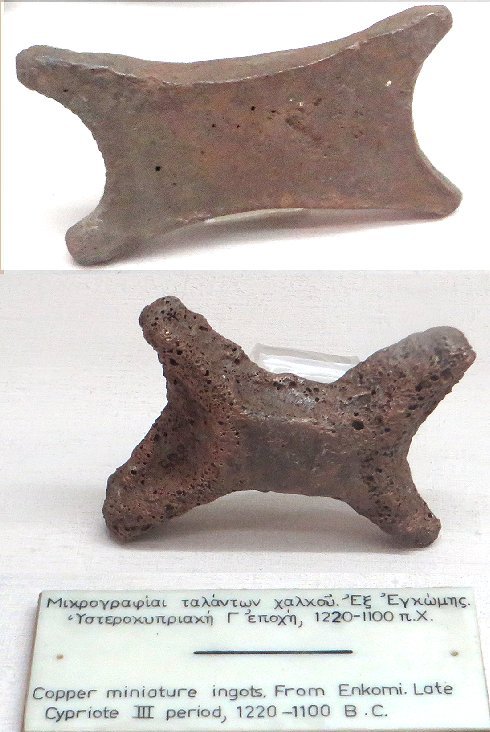 |
| Miniature copper ingots. Toys for kids? Samples for the salesperson? |
| Source: Photographed in the Cyprus Museum in Oct. 2016 |
|
| | |
|
 |
Of course we also find weapons typical for Cyprus: |
| | |
|
| |
|
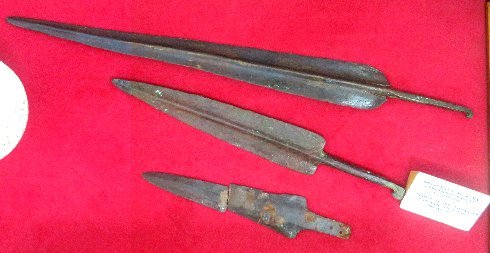 |
Typical "willow-leaf" shaped bronze weapons of Cyprus.
These beauties are from the .... |
| Source: Photographed in the in Oct. 2016 |
|
| | |
|
| |
|
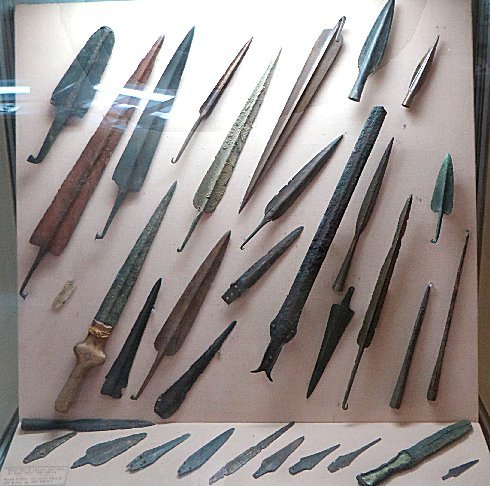 | | Bronze weapons in the Cyprus Museum |
| Source: Photographed in the in Oct. 2016 |
|
| | |
|
| |
 |
Nice but no match for what you find in "my"
museum in Schleswig, Germany. While the Cypriots had the copper and made bronze in large quantities, the old Germans
up north couldn't make those things but obviously were wealthy enough to buy the stuff in quantities, And that's why you
find it there.
Future archaeologists will find lots of good stuff in Saudia Arabia and thereabout even so these guys
cannot make a cell phone or a Mercedes. They will find very little at the places were cell phones were made. And where is
that? Do you know? |
| |
| |
 |
More interesting perhaps than the weapons is the collection of bronze tools exhibited
in the museum. Here are some examples: |
| |
| |
| |
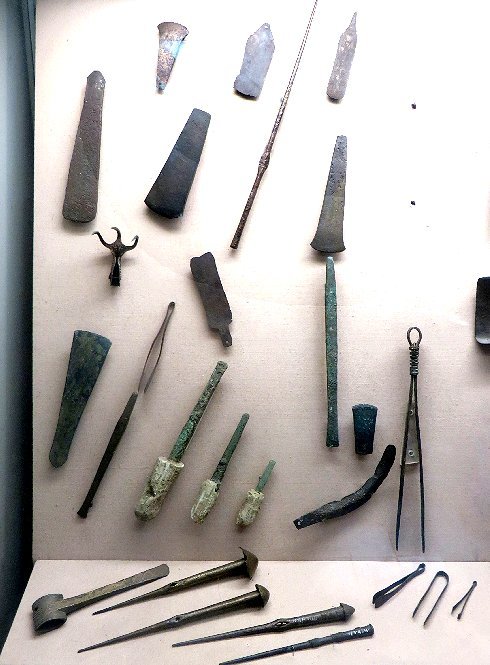 |
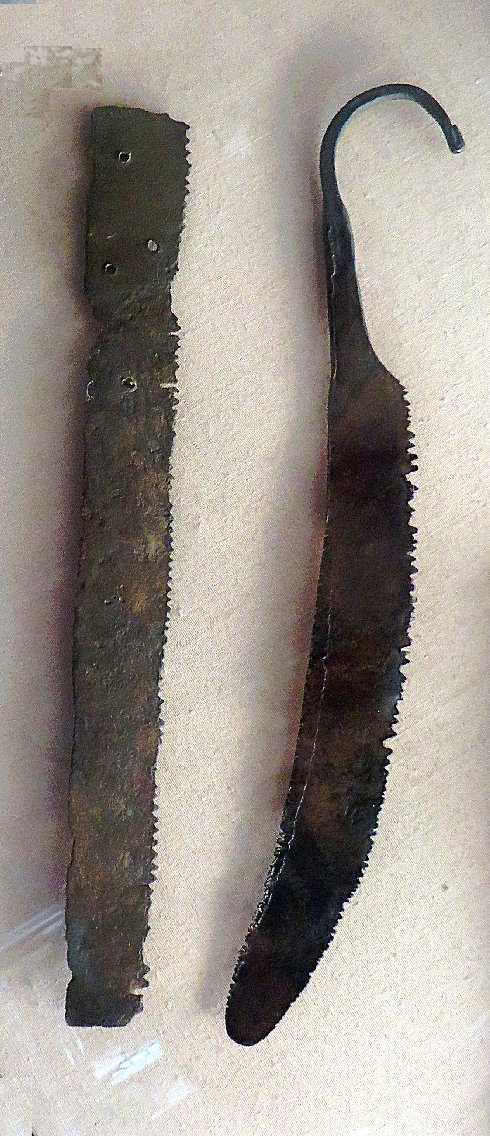 | | Bronze tools |
| Source: Photographed in the Cyprus Museum in Oct. 2016 |
|
| | |
|
|
 |
Then we have the pendant to the big bronze cauldron stand shown here. They also have a huge and showy bronze cauldron but I will not show this here. |
| |
|
|
|
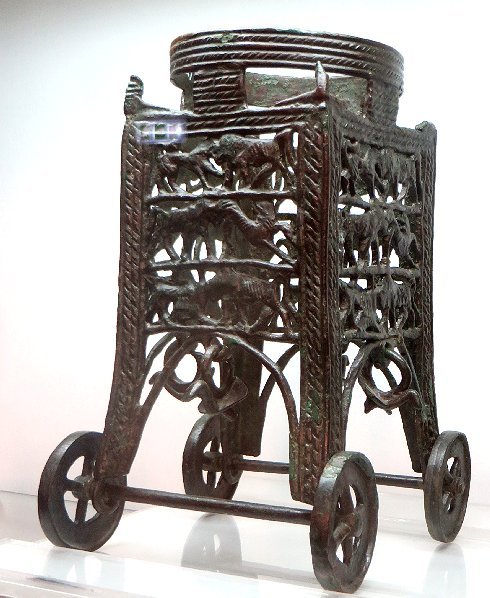 | | Bronze cauldron stand
|
| Source: Photographed in the Cyprus Museum in Oct. 2016 |
|
| | |
|
 |
How about iron? The following pictures shows the (almost) complete
collection: |
| | |
|
| |
|
 |
| "Roman Sword", Iron (2nd - 3rd century AD)
|
| Source: Photographed in the Cyprus Museum in Oct. 2016 |
|
| |
|
 |
To conclude: If you make it to Cyprus, go see the museum. Watch out
for the details! It is definitely good for a few hours of pleasurable education and good fun. |
| | |
© H. Föll (Iron, Steel and Swords script)




















